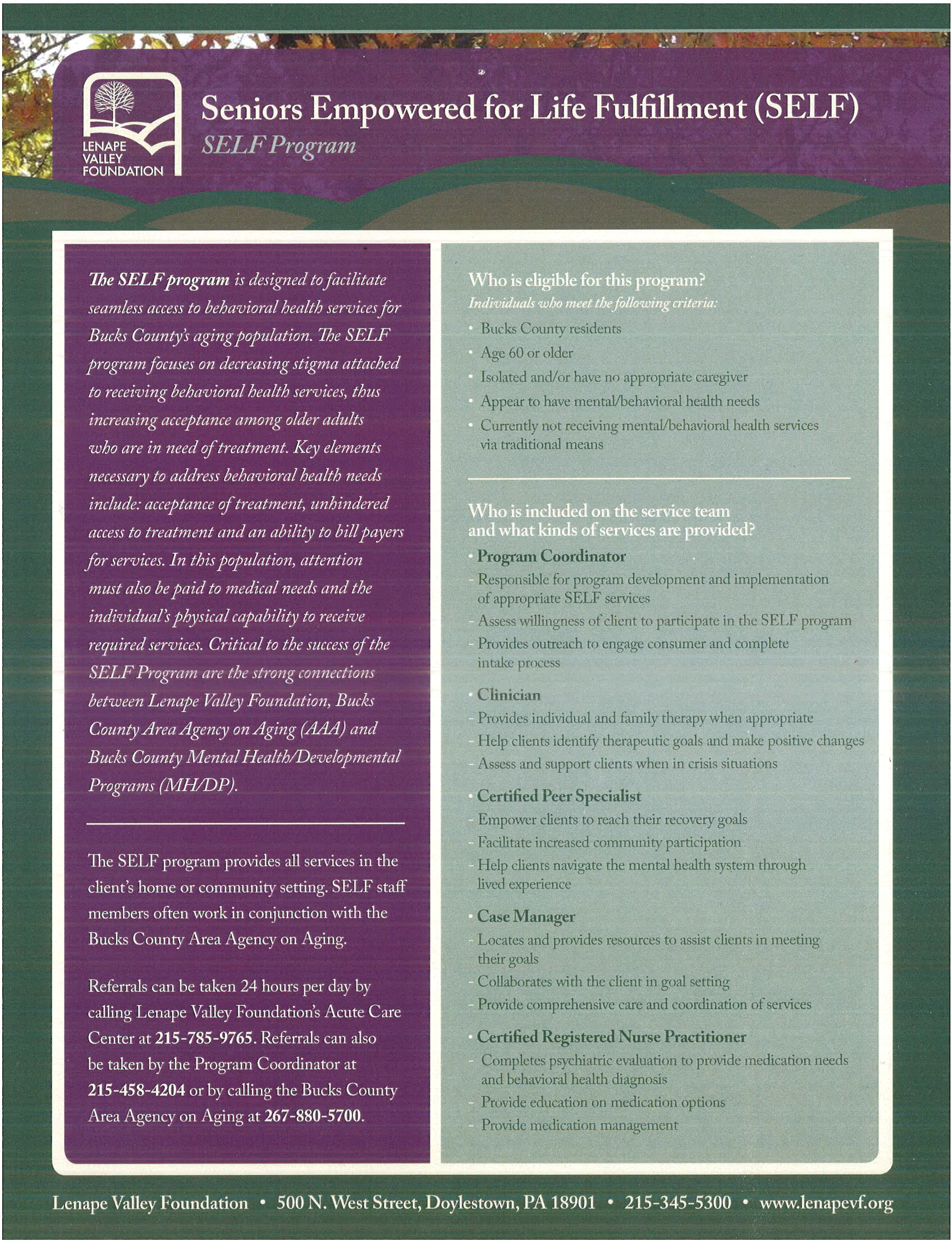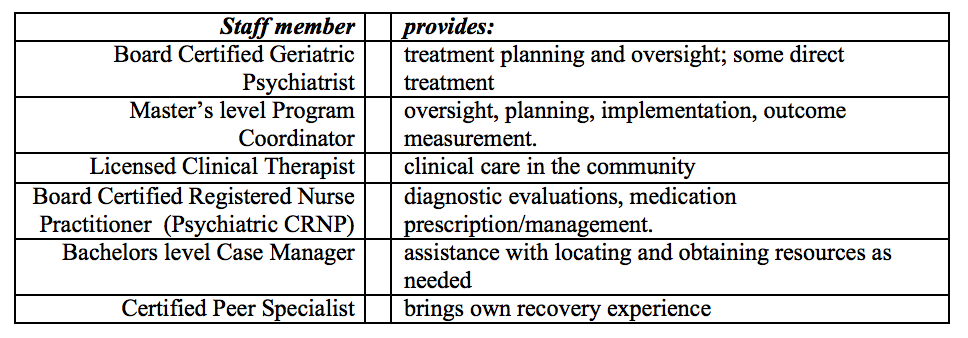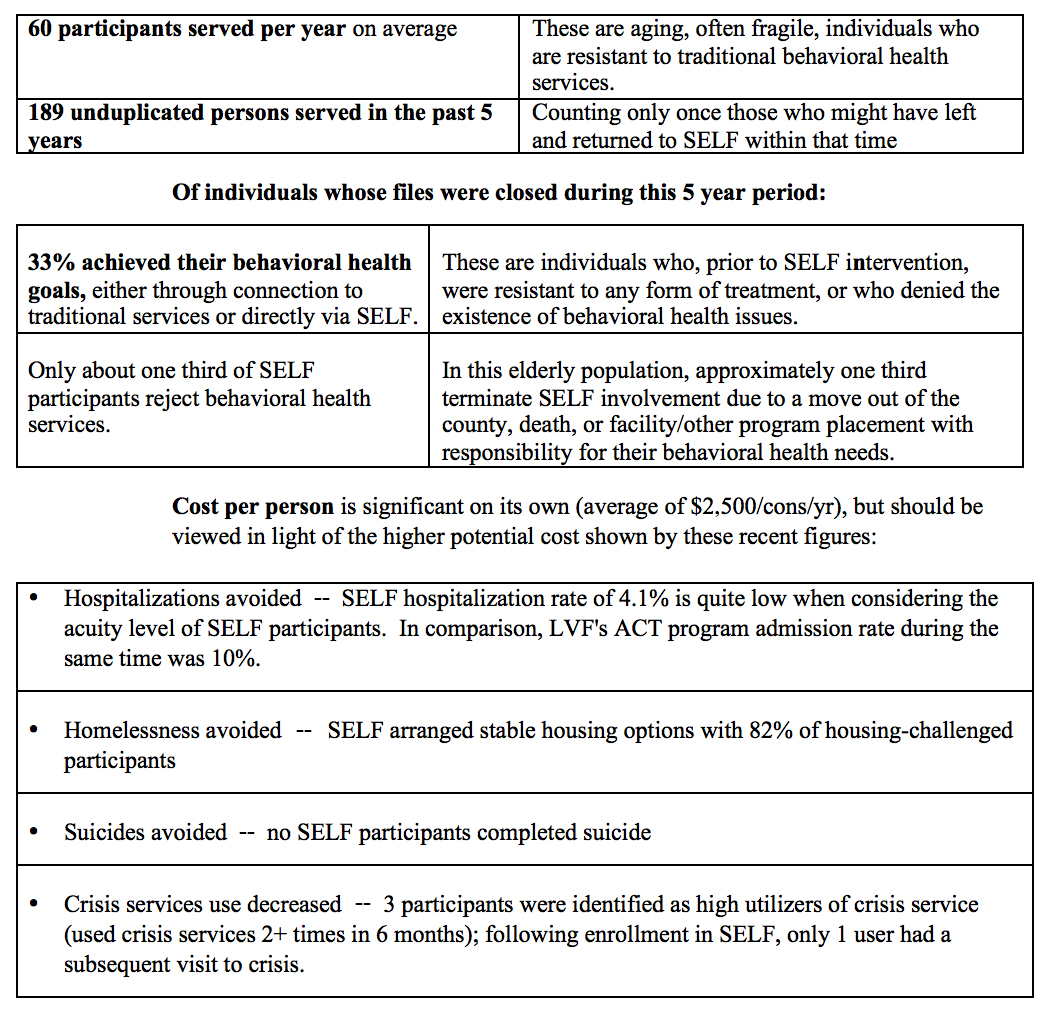“I’m fine. Just get those men out of my trees.” These were the words of an older woman in Langhorne, Bucks County, whose neighbors had called the Area Agency on Aging concerned over her closed blinds and her withdrawal and isolation from the neighborhood. Her words are characteristic of many older adults who have unmet mental health needs that are impairing their functioning -- needs which this age cohort will often deny, decline treatment for, or not even recognize.
Bucks County AAA estimates unmet mental health needs in approximately five to 10 percent of its ongoing population of older adults. In addition, an unknown number of older adults with unmet mental health needs are believed to be living in the community, unconnected to either the mental health system or to the aging services network. The reasons for this vary, but the most common are:
- In the existing system, an older adult must want treatment and contact a mental health provider to request it. For this cohort of elders, merely acknowledging a mental illness, let alone calling a Mental Health provider to request treatment is stigmatizing.
- Some individuals have persistent and severe needs, but their illness prevents them from recognizing their needs and seeking treatment.
- Those who do seek treatment must then travel to the provider’s site, a trip that is often prohibited by the very mental illness requiring treatment, by the elder’s physical health limitations, and/or by the lack of affordable transportation in this suburban county.
- Funding for mental health treatment is often an issue, especially for this target group of older adults who saw no need for treatment and certainly would not pay for it.
The service system needed a new design to respond to the needs of these older adults in ways acceptable to them.

Out of this concern for Bucks County older adults who appeared to be in need of mental health services but unable to receive them successfully via traditional sources, the idea for a new program was conceived. Staff from the County’s Area Agency on Aging (AAA), its Mental Health/Developmental Programs Department (MH/DP), and the County’s contracted Behavioral Health Services (BHS) provider collaborated to innovate ways to surmount these barriers by providing services in a non-traditional manner to this population. What was needed was to marry the ability of the AAA to routinely provide home visits and its lack of stigma in the eyes of this population, with the mental health system’s ability to perform assessments and provide treatment. Thinking outside the traditional system modalities was encouraged.
The SELF Program (Seniors Empowered for Life Fulfillment, formerly called SeniorReach) was born. The AAA and MH/DP would contract with a treatment provider to meet the goal of linking targeted older adults to the behavioral health treatment they needed in several innovative new ways:
- Stigma: SELF would be housed in the AAA, and terminology modified in order to reduce stigma.
- Outreach: Instead of requiring onsite intake and psychiatric evaluation as the gateway to treatment, SELF provides outreach to targeted older adults upon referral by anyone.
- Criteria: The SELF program is designed for Bucks County residents age 60 or older who are isolated, whose apparent behavioral health needs negatively impact functioning, and who have no behavioral health treatment or connection.
- Location: Assessment and care are offered in individuals’ homes and other sites more acceptable to an older individual with unrecognized mental health needs, such as libraries, coffee shops, senior centers, or even at times, in their car.
- Engagement: Since the target population is not ready for behavioral health services and may not even recognize their own need, the SELF program begins with a staff member whose role it is to create a relationship with the older adult -- an activity dubbed “engagement” which does not exist in traditional services. Any activity within reason that serves to build this relationship and work toward linkage to services is permitted. This may take the form of assistance with transportation to and from doctor’s appointments, assistance with bill paying, help with moving from one home to another, obtaining financial benefits, or assistance with activities of daily living. Staff may continue with engagement activities for the time needed to assist the person to an understanding of their need for treatment and developing a willingness for same. Although, some individuals do not achieve this step, and for them, the program ends here.
- Treatment: Once the individual is willing, the clinician develops diagnostic impressions and treatment plans which they carry out with the person. Over time, s/he accepts a warm transfer to traditional services or meet their own goals of reduced symptoms and increased ability to manage their illness.
- Structure: The SELF program utilizes a team approach incorporating Mental Health staff, Aging staff, and program staff to accomplish its goal. The SELF Program is funded and overseen by the AAA and MH/DP, and carried out by a contracted provider, Lenape Valley Foundation (LVF), which employs the staff of the SELF program. Staff of all three entities collaborate to provide cross-training in issues and services available in each one’s areas of expertise. Integral to this is the close involvement of a Supervisor from the AAA who acts as liaison between AAA staff and the SELF staff for all referral approvals and other day-to-day operations. The solid connection between MH, AAA, and SELF program staff facilitates understanding of the abilities and limits of each entity’s programs and increases innovations and successful outcomes.
- Staffing: The contracted provider, LVF, employs the following staff:

- Collaboration and Communication:
➢ At the direct service level, AAA Care Managers and SELF program staff maintain close contact regarding mutual clients, and may make joint visits as needed. These often occur upon initiation of the case with SELF, as a means of transferring trust from their AAA Care Manager to the SELF program staff.
Quarterly case conferences are held with direct service and administrative staff from all entities -- AAA, MH, and SELF -- for communication and brainstorming opportunities about challenging situations.
➢ SELF staff hold internal team meetings weekly to ensure that all involved staff are updated on active cases and plan(some individuals access SELF directly, without an AAA Care Manager).
➢ All three agencies meet quarterly at the administrative level to review policies, analyze data, address rising issues, and plan for the future.
➢ The program is monitored annually by the funding agencies.
- Funding:
➢ SELF is funded by the County AAA and Mental Health departments, with the latter providing the bulk of the funding. The County’s BHS provider initially brought Medical Assistance Reinvestment dollars to the program, but later ceased participation when it was clear that almost no SELF participants qualified for or needed state Medical Assistance funding.
➢ Funding has been limited, and the contracted provider, LVF, has absorbed some of the program’s costs each year as well.
➢ Insurer requirements for copays from at least some individuals has been challenging, but no one has had services terminated for non-payment.
- Outcomes: Some older adults’ behavioral health needs could be met and a formerly isolated person could begin recovery and find a meaningful role in the community.
➢ Statistical outcomes:
All consumers served:

- Person-centered outcomes:
➢ Mary was an 83 year old female referred by the local Victim Assistance agency in distress regarding her housing and struggle with depression.She had relocated to this area after selling her home of 38 years in another state and purchasing a home with her daughter and son-in-law where they all would reside.
The relationship with her son-in-law deteriorated to the point of violence, and the couple abandoned her in the house with a mortgage payment she could not afford. She was extremely depressed and hopeless, stating, “I will just end up homeless and I don’t care.”
As SELF staff offered both cognitive therapy and emotional support, she began to make arrangements for herself and to use the community around her as a resource. She purchased a mobile home in a community where she has several friends. The symptoms of her depression dramatically decreased; she is recovering from this traumatic event.
➢ Robert was a 60 year old male veteran who lost his job as a result of a motor vehicle accident and back injury. Since then he has been isolated in his home, experiencing increasing symptoms of depression, hoarding, and explosive anger.
His wife was greatly concerned about these behaviors and since Robert was not amenable to seeking assistance himself, she asked for help from her AAA Care Manager who referred the situation to the SELF program. Engagement with Robert took over a month, but he ultimately allowed the SELF clinician to take him out for coffee. They addressed his symptoms of depression and discussed the possibility of medications. The AAA Care Manager assisted the family with overdue tax bills and possible eviction, food costs, utilities, transportation, and connection to the Veterans’ Assistance Office. After some months, Charles was recommended for and considered becoming a Certified Peer Specialist!
➢ Leslie, age 85, had somatic hallucinations of “bugs eating me” causing anxiety and poor sleep. She accepted an escort from SELF staff to accompany her to see a new physician who completed a medical workup which was negative for medical conditions. While she currently refuses outpatient BHS, she has accepted medication for the hallucinations, which are now less distressing and she is able to sleep and concentrate. It is hoped that this may help her in ongoing work with SELF staff to engage more actively in her own recovery.Conversely, another participant had a similar sensation, and the SELF CRNP did observe and provide treatment for an actual infestation in her skin, also leading to symptom reduction and the ability to concentrate on recovery.)
- Additional learning:
➢ Cross-systems training and communication were invaluable.
➢ A single release form acceptable to all parties involved, including BSUs, facilitated communication.
➢ Status as a demonstration program and grassroots-level work permitted SELF to be nimble; several data-driven redesigns occurred:
- The inclusion of a Psychiatric RN proved pivotal to participants' and the program’s success.
- Engagement was initially via the SELF Clinician, but later modified to move the SELF Care Manager into this role.
- Inclusion of a billable therapist to capture all possible revenue resulted in significant service delivery challenges in exchange for negligible revenue, and was later discontinued.
➢ SELF brought attention to other gaps in the behavioral health system, such as:
- Copayments required of individuals who cannot afford or are unwilling to pay them yet who have an urgent need for treatment.
- The absence of addiction treatment for individuals who are not otherwise independently functional.
- The need to ensure that services and the funding for them will actually be available at the time the older adult finally does agree to accept them.
Summary:
Three agencies in Bucks County -- Bucks County Area Agency on Aging, Bucks County Mental Health/Developmental Programs, and Lenape Valley Foundation -- are collaborating to provide outreach to adults age 60 and over who have mental health needs which have not been met through traditional means, and link them to needed diagnostic services and treatment in their community, through the SELF Program. The linked services are primarily mental health services, but other forms of assistance may also be needed and linkage is provided. Many older adults’ unmet behavioral health needs are now being met and formerly isolated individuals are beginning recovery and finding meaningful roles in the community.
Authors’ bios:
Gail Forth is a Supervisor in the Long-Term Care Unit at the Bucks County Area Agency on Aging, where she supervises staff in several units. She has been involved with the SELF program since 2006 and is responsible for reviewing and approving all SELF program referrals, as well as day-to-day operations of the program.
Lois Tobin, MSW, LSW, is Deputy Director at the Bucks County Area Agency on Aging, responsible for the Long Term Care unit which includes multiple programs including SELF. She was one of the initial designers of the program, and remains involved in the administration of the program. She is a member of the National Association of Social Workers, the Bucks County Women’s Advocacy Coalition, and past Board member of the Professional Care Management Institute.


